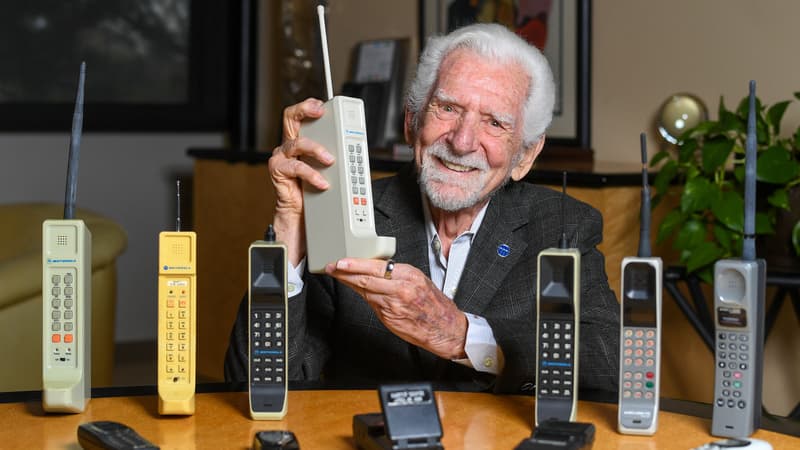From the single-task bricks in its beginnings to the technological jewels that today offer infinite applications, a retrospective look at half a century of revolution in mobile telephony.
On April 3, 1973, Martin Cooper, a Motorola engineer, made the first call from a mobile device, the Motorola DynaTAC, on 6th Avenue in New York. The recipient is Joel Engel, a competitor who works for Bell Labs.
It took ten years for the first mobile to be marketed in 1983. The Motorola DynaTAC 8000X costs $3,995. Nicknamed the brick, it measures 33 centimeters and weighs 794 grams.
1992: “Merry Christmas”, first SMS
On December 3, 1992, the first ever text message, “Merry Christmas”, was sent to Vodafone employee Richard Jarvis from a computer. This message, sold in the form of NFT, reaches 132,680 euros (150,000 dollars) at auction at the end of 2021.
Starting with the Nokia 6110, released at the end of 1997, the Snake game provides entertainment for users of Finnish brand phones.
Released in 1999, the Nokia 7110 paved the way for mobile Internet, thanks to WAP technology. The same year, the Nokia 3210 integrates predictive typing (T9) for the first time, which speeds up SMS writing. It is no longer necessary to press the same key several times to type a letter.
In Japan, Kyocera is launching the VP-210, which features a front-facing camera for video calling and storing up to 20 photos. Its competitor Sharp released the SH04 the following year, the first laptop with an integrated rear camera.
2000: The iconic Nokia 3310
Nokia launched its legendary 3310 model at the end of 2000, a bestseller appreciated for its robustness, simplicity and battery life.
In 2001, Japan was the first country to benefit from third-generation (3G) mobile telephony, which provides high-speed Internet access.
In late 2003, Nokia launched a new entry-level model, the 1100, aimed at developing countries. Very economical, it is the best-selling laptop in history (250 million copies).
The American Apple made a notable entry into the mobile phone market in 2007 with theiphone, with an innovative design and touch screen. It costs $499 or $599 depending on the model, when the iphone the current ones easily exceed 1,000 euros.
Since 2008, the device has been powered by an online app store, the AppStore. At the end of 2008 the HTC Dream was launched, the first smartphone equipped with the Android operating system developed by Google.
2009: Launch of WhatsApp
The WhatsApp application, today number 1 in instant messaging, was launched in 2009, followed by many others such as Viber, WeChat, Telegram or Signal. Its messages transmitted over the Internet supplanted SMS from 2012. In December 2009, Stockholm was the first city to offer users 4G coverage, a very high-speed mobile technology.
Apple launched in 2011 its iphone 4S, which integrates the Siri voice assistant for the first time. It allows you to use your voice to send messages, schedule appointments, make calls, or even search the Internet. Google and Amazon will develop competitive voice assistants.
The “emoji” fever took over the planet in 2011 when these small images of emotions, sketched in 1999 by the Japanese Shigetaka Kurita, were integrated into the character library of theiphone.
Since the summer of 2016, the worldwide success of the game Pokémon Go, which allows you to catch virtual creatures in the real world, democratizes augmented reality.
On April 5, 2019, South Korea was the first country to be covered by 5G, the promise of near-instantaneous browsing. The South Korean groups Samsung and the Chinese Huawei are in 2019 the first big manufacturers to launch smartphones with a folding screen, the Galaxy Fold and the Mate X.
Source: BFM TV


